CourseConnect
UX/UI Design
Overview: CourseConnect is an application designed to help students foster a stronger sense of belonging on campus by encouraging meaningful connections within their classes. By blending social interaction design with academic support features, the app aims to make it easier for students to break the ice, build relationships, and collaborate in their learning environments.
Responsibilities: As part of a team, I was involved in every stage of the UX process from conducting user interviews and synthesizing insights through affinity diagramming to creating paper prototypes, running usability tests, and iterating on designs based on feedback. I contributed to designing wireframes and the final high-fidelity prototype, as well as co-authoring a comprehensive paper that detailed our design decisions, methodology, and findings.
Timeline: 5 weeks
Tools: Figma
Team: 4 Designers
Problem Statement
Many college students struggle to feel connected on campus. This isn't a new phenomenon, but it's definitely gotten worse after years of remote learning and social distancing during the COVID-19 pandemic. Even with social media and online platforms everywhere, it’s not always easy to find genuine connection or feel like you truly belong. We wanted to explore how we could design a digital experience that helps students build meaningful relationships and feel a stronger sense of community.
Background Research
The pandemic disrupted how young people connect with others, leaving many feeling isolated and disconnected. For many college students, that sense of disconnection is still strong. Starting college can be overwhelming, and forming friendships or finding a community isn’t always as easy as joining a club or event. While tools like Snapchat, Instagram, or Reddit offer ways to connect, they can also make students feel more alone, especially when those spaces are full of unmoderated discussions and people who don’t share similar experiences.
We looked into how students, especially first-gen, low-income, or international students, use digital tools to try and find support. We found that while there are apps aimed at reducing loneliness or promoting connection, they fall short of helping students truly find their place. These gaps show there’s an opportunity to design something better: something that’s not just another social platform, but a space where students can connect authentically, share experiences, and build a real sense of belonging.
Interviews
In an effort to understand students' experiences with belongingness on campus, we conducted several interviews. We focused on the follow questions, following Patton's five key areas for qualitative research interview questions (Experience/Behavior, Opinions/Values, Feelings, Knowledge, and Sensory), while making sure to keep them open-ended.
• How do you define the word belongingness?
• Do you think the Northeastern community prioritizes belongingness? Why or why not?
• Can you tell me what resources Northeastern has to promote belongingness on campus?
• Give me three words to describe your sense of belongingness on campus. Why did you choose those words specifically?
• Which campus activities organized by Northeastern do you find helpful or are curious about?
• What advice would you give to someone who struggles to feel a sense of belonging?
• Once you’ve established a connection with someone, what helps strengthen that relationship over time?
• Can you describe a time where you felt a strong sense of belonging without actively working for it?
Key Takeaways & Analysis
Across our interviews, students consistently described belongingness as a mix of feeling accepted, comfortable, and connected, usually shaped more by interpersonal relationships than by physical spaces or university programs. While Northeastern offers many opportunities to connect (like through clubs, co-op, and study abroad programs), students felt that building community still falls heavily on individual effort.
Our interviews highlighted that belonging at Northeastern isn’t about the number of programs or resources but rather about how easy it feels to make and maintain meaningful relationships. Students crave genuine connection, but many feel that they have to work hard to find it. Those in smaller, more structured groups (like Global Scholars) seemed to form friendships more naturally, suggesting that forced proximity and repeated interaction can make a big difference. Students also expressed a clear interest in technology that could help them connect socially in a more personal way. Academic tools like Piazza feel too formal, and platforms like LinkedIn feel too superficial. One student even suggested creating a Northeastern-specific app that helps students find others with similar interests, classes, or living situations; one that was more casual and community-focused.
Affinity Diagram
Affinity Diagram Analysis
In our affinity diagram, we identified these top level themes: Frequent interactions online & in-person, and social connection in inclusive and welcoming communities. Overall, students’ sense of belonging is shaped by both structured opportunities for interaction (classes, clubs, study programs) and personal efforts to connect with others, with technology playing a key role.
Frequent interactions online & in-person:
Maintaining/building connections with technology: Our interviewees identified technology and social media applications, like Instagram, as essential tools for forming and maintaining connections. It facilitates communication between friends, classmates and clubs.
Recognition & Familiarity in real life settings: Connections are often made/strengthened in environments that require constant interaction and repeated encounters, like in classes. Many of our quotes outlined proximity and familiarity as a factor for forming connections over time and feeling a sense of belonging.
Social Connection in inclusive and welcoming communities
Shared Academic Experiences & Relatability: Our interviewees highlighted experiences with forming connections due to shared academic struggles or shared participation in fun events/academic programs. Some mentioned feeling comfort since they know that they’re not alone in their struggles. Others have experiences in forming super close bonds in study abroad programs where student populations tend to be smaller and more tight-knit.
Belongingness relies on the people: Diversity and inclusivity are key factors in creating a welcoming environment, but building connections often requires personal initiative. Some students find it challenging to break into established social groups, particularly in a competitive and sometimes individualistic campus culture.
User Personas
Proposal
Our top design ideas are CourseConnect and StudyBuddy, both focused on integrating social connection with academic support to foster belonging. CourseMates is a class connection app that helps students get to know others in their courses, while StudyBuddy allows users to create or join study groups by selecting a place, time, and subject, with options to invite others. These tools encourage both online and in-person bonding, especially for students new to a field or campus who may feel hesitant reaching out for help. Unlike faculty-run tools like Canvas or Piazza, these apps are designed with the student experience in mind.
Based on Jenna’s needs, these tools are a great fit. She forms strong connections through regular face-to-face interactions, especially in academic settings. Since classes are part of her daily routine, she’s most likely to bond with classmates, especially when they can support each other academically. CourseMates and StudyBuddy connect Jenna with classmates who are also open to forming friendships and study partnerships, helping her feel less isolated in challenging courses.
Digital Wireframes
Onboarding

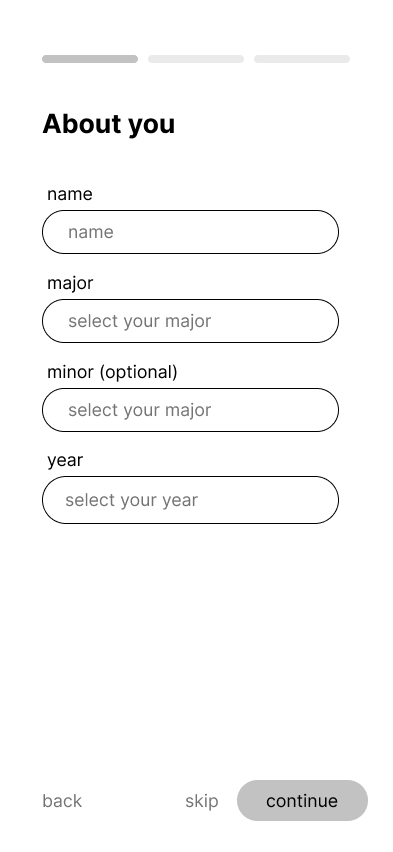
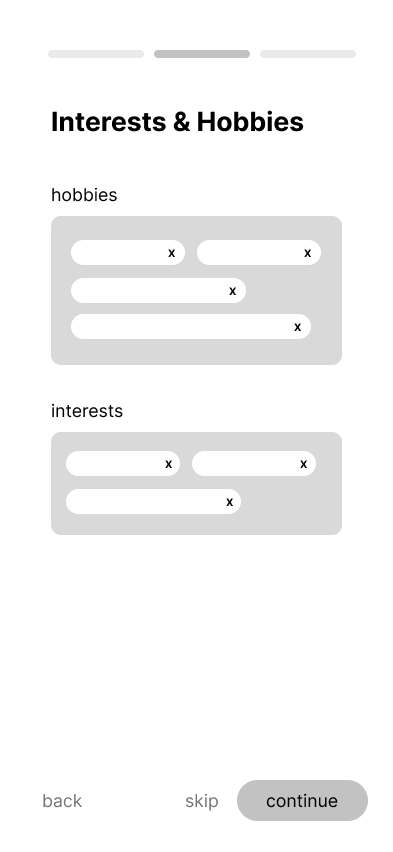
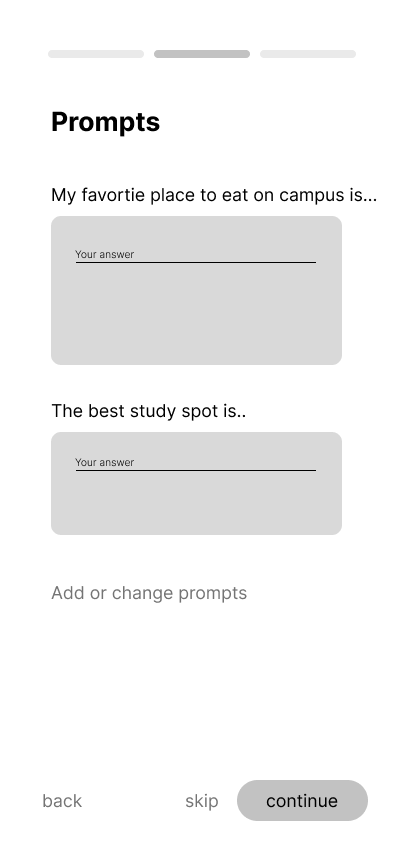
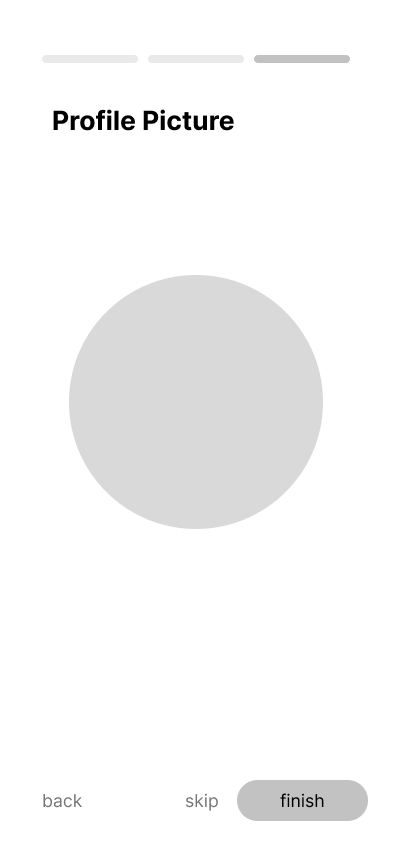
Screens
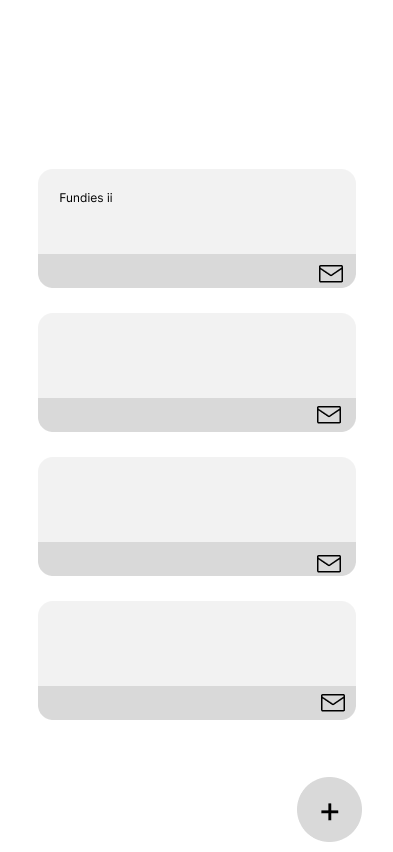
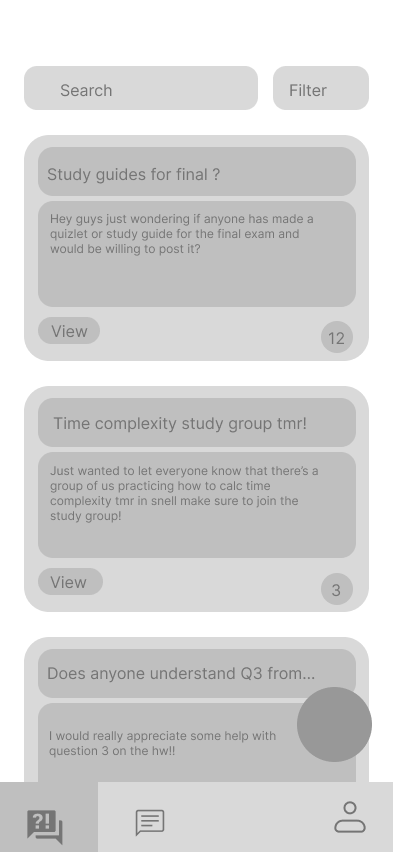

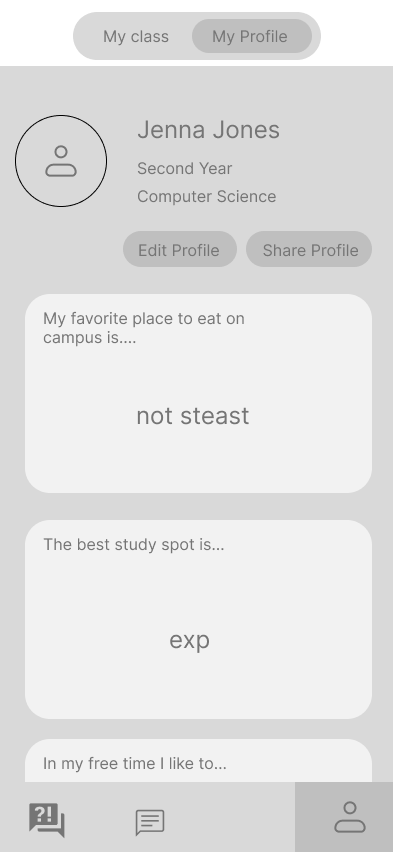

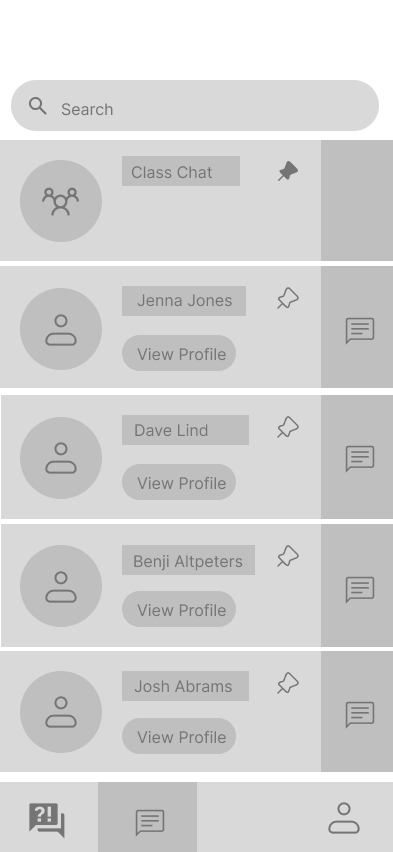

Usability Testing
We conducted a usability test of our CourseConnect paper prototype with two Northeastern students. The goal was to evaluate how well users could navigate core features designed to foster classroom-based connections. Participants completed four tasks: checking if others were struggling with an assignment, messaging a classmate, editing their profile, and creating a study group.
Key Insights
Our usability test analysis focused on two main themes, namely Navigation and User Comfort, with four supporting categories: Icon Recognition, Organizational Features, Feedback, and User Enjoyment.
Navigation and Icon Clarity: Some icons (like the book for study groups and envelope for messages) were misinterpreted, indicating a mismatch between user expectations and visual cues. Consistent and recognizable icons, like plus/minus signs, were more intuitive.
Organization & Layout: Features like dropdowns to add interests and the prominent placement of the “new post” button supported easy navigation and followed usability principles like Fitts’s Law and minimalist design.
Feedback & Error Prevention: Participants noted a lack of confirmation when deleting profile prompts, suggesting the need for clearer feedback to prevent accidental actions.
User Control: Users wanted more control over their interactions (such as the option to post anonymously) to feel more comfortable using the open forum.
High Fidelity Prototype & Demo
Takeaways
If we had more time, we would have improved our data collection process by doing broader and more targeted outreach. While we interviewed students of varying majors and years, we didn’t specifically target certain demographic groups. For example, the experience of belongingness might differ for students who study abroad, commute, are in specific student organizations, or are part of marginalized communities. Gathering insights from these groups would help us support a wider audience.
We also would have revisited our early ideation sessions. At the start, our team gravitated toward campus-focused ideas, which may have limited creativity. Belongingness isn’t always found through school-run initiatives, and there are other areas we could have explored to encourage social connection. In a future iteration, we would incorporate more divergent thinking exercises and draw inspiration from unrelated platforms to discover less conventional, more innovative solutions.
Lastly, while our usability testing focused on feature-specific feedback, we would have spent more time exploring the emotional experience of using the app. Belonging is inherently emotional, and understanding how users feel while using the platform would have helped us better design for long-term engagement and trust.

